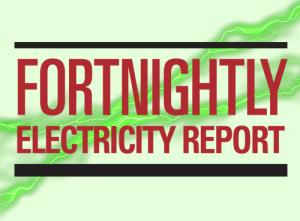Shelter-in-place became the rule nationally by April 1 though many states had started it much earlier. So our first edition of the Fortnightly Electricity Report is for the period of April 1 through April 14, that is, the fortnight through Tuesday night.

And there’s a lot of big news for us to report. First, electricity use in the continental U.S. was down 5.9 percent, as compared to April 1 through 14 of the prior year. Wow, 5.9 percent is an enormous drop, in large part undoubtedly from the virus crisis.
The greatest decreases in electricity use were in the southeast, New York, the Carolinas, PJM and MISO. On the other hand, electricity use didn’t fall in Texas and Florida.
Hourly peak demand in the continental U.S. decreased as well during the two weeks, year-over-year, though somewhat mildly, by 2.3 percent. This makes sense given the considerable switch from commercial to residential use of electricity resulting from shelter-in-place.
Perhaps the biggest news from the first edition of the Fortnightly Electricity Report concerns coal plant generation. The coal plants in the lower forty-eight states produced a truly remarkable 36.4 percent less electricity in April 1 through 14 of 2020 than in April 1 through 14 of 2019.
Plus, coal plants produced just 15.1 percent of total electricity generation during the just-completed period. We estimate that might be the lowest percentage for the nation’s coal plants since the 1930’s.
Why has coal plant generation fallen to such low levels? Well, as we said, electricity use is down and some competing sources of generation such as nuclear are steady and don’t go down with electricity use, squeezing the market share for coal. But it must be the case that the unusually low price of natural gas is favoring gas plants over coal plants. This is likely playing an important role in coal’s fall.
Indeed, the share of total electricity generation by zero-emission sources — nuclear, hydro, wind and solar — was 44 percent in the two-week period ending April 14. That’s perhaps a record high for the country.


